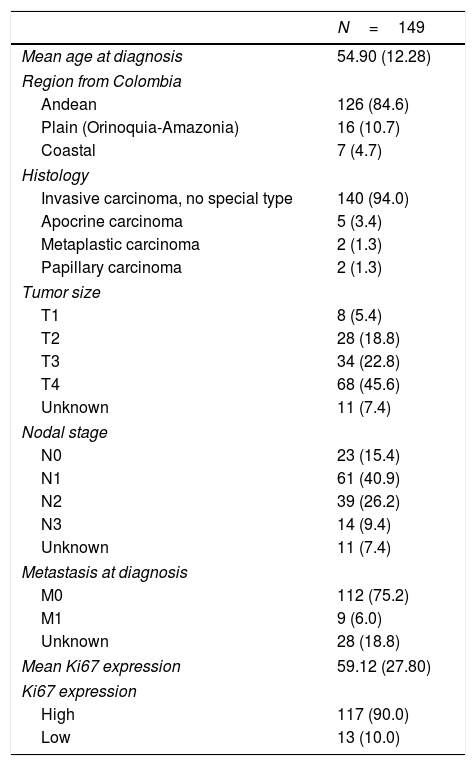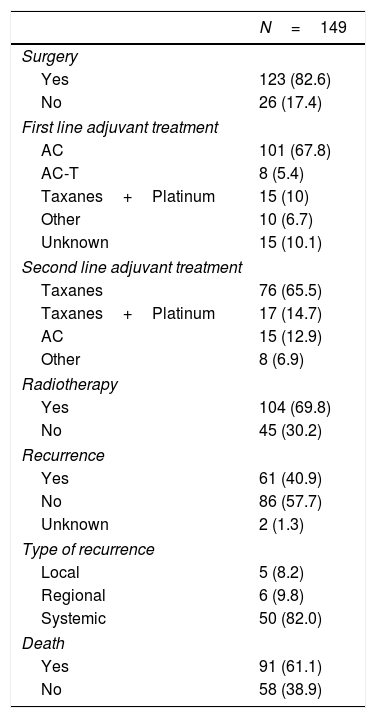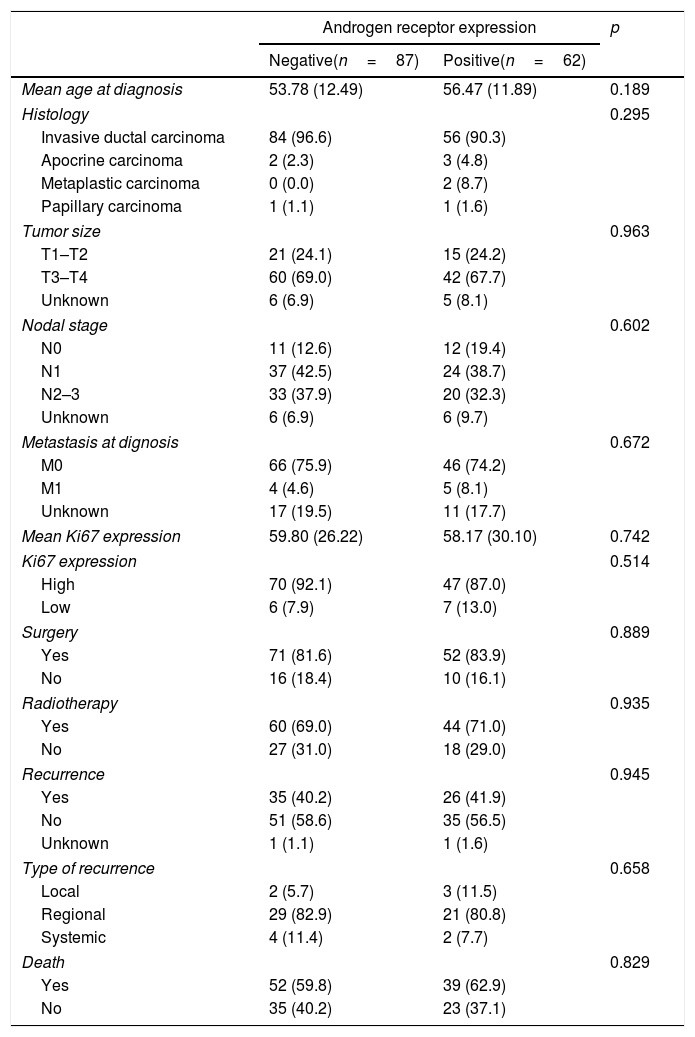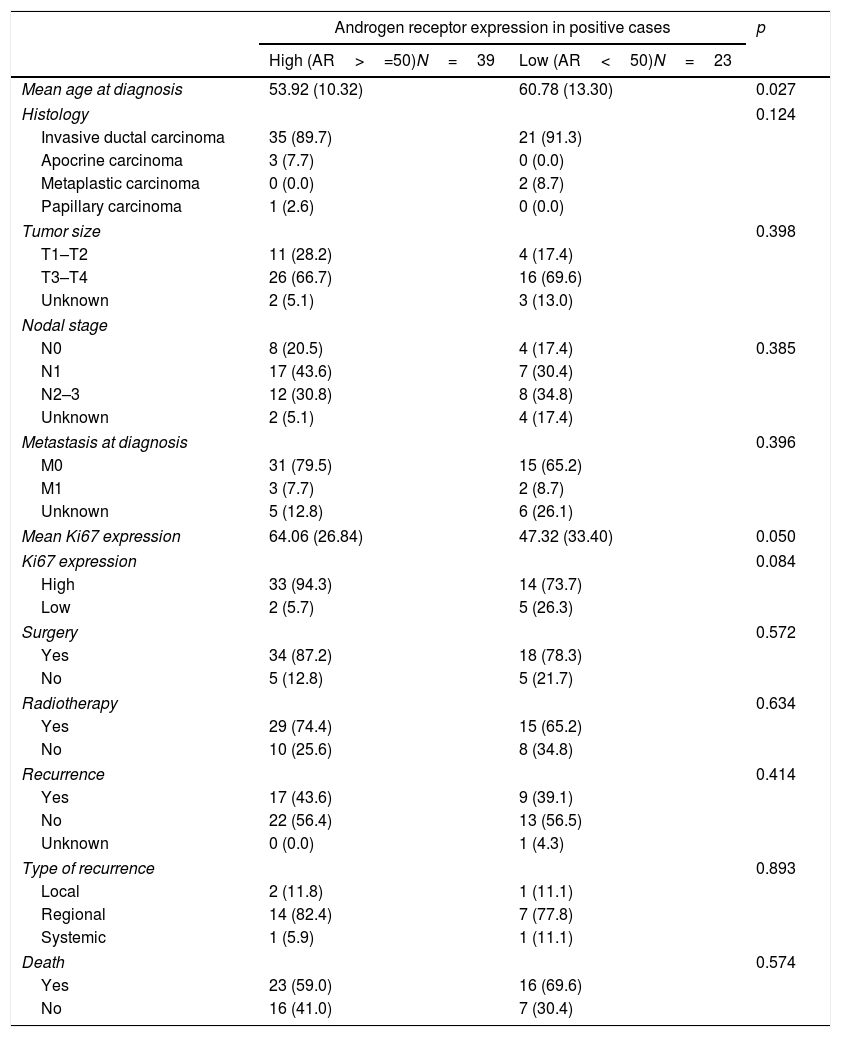Triple-negative breast cancer (TNBC) is an aggressive subtype that has no available molecular targets. It occurs most often in premenopausal African-American and Hispanic/Latino women. In Colombia, its prevalence has been reported to be 20.6%. Androgen receptor (AR) belongs to the steroid nuclear receptor family and has been recently considered a potential biomarker for breast cancer. Considering the high prevalence of TNBC in Colombian women and the lack of knowledge of AR expression, our aim was to determine the frequency of AR expression and its association with pathological variables.
Materials and methods149 women diagnosed with TNBC between 2011 and 2014 were included. Clinical and pathological data were obtained from medical and pathology reports. Information on hormone receptor status, Ki67 expression and HER2 was reevaluated by a pathologist. AR expression was considered positive when it exceeded 1% of nuclear staining in tumor cells.
ResultsAR expression was detected in 41.6% of the samples. Although we did not find statistically significant differences in clinic-pathological variables according to AR expression, patients with AR expression over 50% were younger (53.92 years vs. 60.78 years, p=0.027) and presented higher Ki67 expression (64.06% vs. 47.32%, p=0.05), compared to patients with a low AR expression. The median overall survival in our sample of TNBC patients was 2.45 years.
ConclusionsThe expression of AR in our sample was similar to the expression in populations of European descent. We found statistically significant differences in age at diagnosis and Ki67 expression according to AR expression.
El carcinoma de mama triple negativo (CMTN) es un subtipo de carcinoma con comportamiento agresivo y sin dianas moleculares disponibles. Se presenta en mujeres premenopáusicas afroamericanas y latinas. En Colombia, la prevalencia informada es del 20.6%. Los receptores de andrógenos (RA) pertenecen a una familia de receptores nucleares y son considerados como potencial biomarcador. Debido a la alta prevalencia de CMTN en mujeres colombianas y la ausencia de datos sobre los RA, el objetivo del trabajo fue determinar la frecuencia de RA y su asociación con otras variables histopatológicas.
Materiales y métodosEl estudio incluyó a 149 mujeres diagnosticadas con CMTN entre 2011 y 2014. Las variables clínicas y patológicas fueron extraídas de la historia clínica. Los receptores hormonales, índice Ki67 y Her2 fueron reevaluados por un patólogo. Los RA fueron considerados positivos cuando más del 1% de los núcleos tumorales estaban teñidos.
ResultadosLa expresión de RA fue detectada en el 41,6% de las muestras. No se encontraron diferencias significativas en variables patológicas de acuerdo a la expresión de RA. Sin embargo, se observó que pacientes con RA positivos mayor del 50%, eran más jóvenes (53,92 vs. 60,78 años; p=0,027) y presentaban Ki67 más elevados (64,06 vs. 47,32%; p=0,05), comparadas con pacientes de baja expresión de RA. La sobrevida global de las pacientes fue de 2,45 años.
ConclusionesLa expresión de RA en la muestra fue similar a la de poblaciones de descendencia europea. Se encontraron diferencias significativas en la edad al momento del diagnóstico y en el índice Ki67, estratificadas por expresión de RA.













